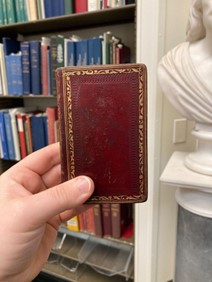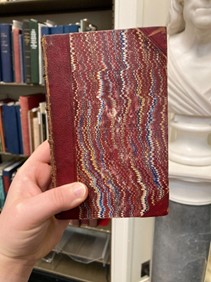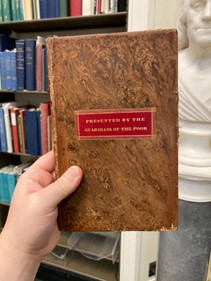The history of the book is predicated on the idea that the book itself as an object is significant in its own right, not simply on its printed content alone. Which materials were used, how they were made, and who made them all speak to a vast network of economic, environmental, and human systems that came together to create a printed volume; these elements of bookbinding are always interesting and worthy of investigation. And if those things are beautiful to behold, even better!
“An Opulence Unexpected” brings together a variety of books bound in red morocco leather, which have been prized for centuries for their beauty and exemplification of a binder’s craft. Also known as “Turkey leather,” it was first produced in North Africa from Turkish goats and exported to Spain as early as the 11th century. It is made traditionally with tawed goatskin stained with sumac (a tangy spice prevalent in Middle Eastern cuisine) for its iconic deep red color. The use of morocco in western book binding became popular in the 17th century, as goatskin leather was supple, long lasting, and took color and tooling well, especially gilt tooling, a method of finishing bindings by pressing gold into covers and bindings with specific tools to create ornate, sometimes lavish, designs.
Morocco was also used in other fine leather goods such as children’s shoes, gloves, and pocket books. Other popular colors of morocco leather include black, green, and blue, with less common colors including yellow and purple. American bookbinding in the 18th and 19th century often used imported morocco sparingly, using the fine leather in a half, quarter, or three quarters binding or in small pieces. Other materials were used to make up the other sections of the binding, such as marbled, pebbled, or book cloth boards, and leathers such as calf or sheep. Morocco leather is still used in contemporary fine bookbinding, and other styles which mimic morocco’s unique texture and finish have been developed. Such prime binding material was used often for gifts, personal items, or to simply demonstrate a binder’s skill. Below are three such volumes from the AAS collections.
 The book of common prayer, and administration of the sacraments, and other rites and ceremonies of the church, : according to the use of the Protestant Episcopal Church in the United States of America. Hartford, 1828.
The book of common prayer, and administration of the sacraments, and other rites and ceremonies of the church, : according to the use of the Protestant Episcopal Church in the United States of America. Hartford, 1828.
Whole bound in red morocco with gilt and blind (without gilt) tooling.
The Water Witch; or, The skimmer of the seas: A tale. / by James Fenimore Cooper. London, 1866.
Half- bound in red morocco with gold tooled spine and non-pareil patterned marbled boards.
A catalogue of the Medical Library of the Philadelphia Alms-House, prepared agreeably to a resolution of the board of managers. / by E.F. Rivinus, M.D. Philadelphia, 1831.
Presentation copy bound in tree calf (light-colored calfskin treated to represent a tree trunk with branches) with red morocco lettering piece, gilt stamped and tooled, on cover.
More examples of red morocco’s use in bookbinding can be found on display in the Reading Room in Antiquarian Hall from February 14 – March 31, 2023.
References:
Berger, Sidney E. The Dictionary of The Book a Glossary for Book Collectors, Booksellers, Librarians, and Others. Lanham: Rowman & Littlefield, 2016.
Miller, Julia. Books Will Speak Plain: A Handbook for Identifying and Describing Historical Bindings. Ann Arbor, MI: Legacy Press, 2010.



